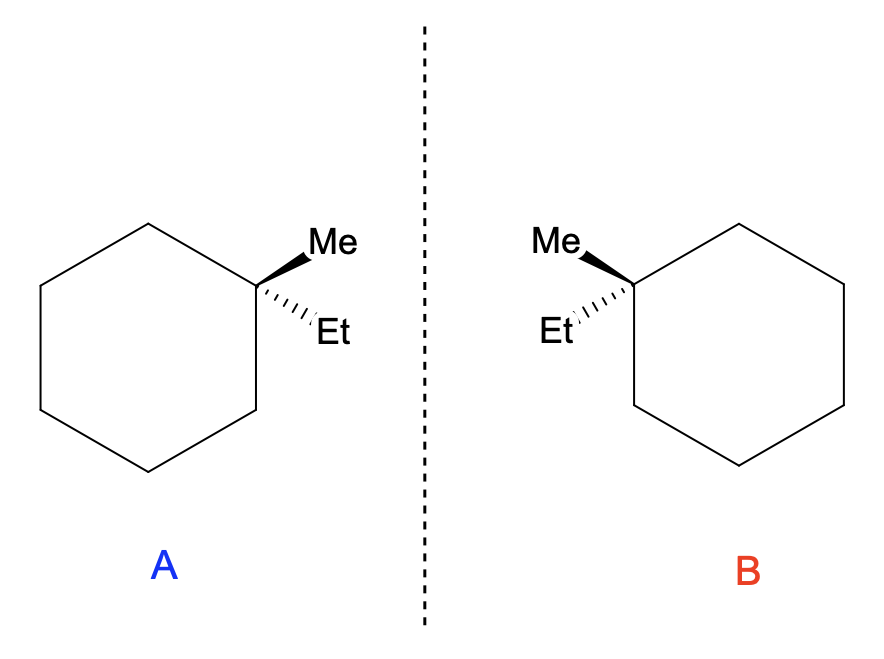Chemistry
10th Edition
ISBN:9781305957404
Author:Steven S. Zumdahl, Susan A. Zumdahl, Donald J. DeCoste
Publisher:Steven S. Zumdahl, Susan A. Zumdahl, Donald J. DeCoste
Chapter1: Chemical Foundations
Section: Chapter Questions
Problem 1RQ: Define and explain the differences between the following terms. a. law and theory b. theory and...
Related questions
Question

Transcribed Image Text:**Instruction:**
"Give an enantiomer of the chair structure below."
**Diagram Explanation:**
The image consists of two rectangular sections. The left section contains the molecular structure of a cyclohexane chair conformation with the following substituents:
- **Bu** (butyl group) at the top left axial position
- **tBu** (tert-butyl group) at the bottom left equatorial position
- **Me** (methyl group) at the top right equatorial position
- **OH** (hydroxyl group) at the bottom right axial position
The right section is blank, indicating a space for the enantiomer to be drawn.
The task is to draw the mirror image of the given structure, which involves flipping the orientation of all substituents to generate its enantiomer. In the mirror image, the positions (axial/equatorial) of identical groups will remain the same, but their orientation (above/below the ring) will change.
Expert Solution
Step 1
First of all, we need to know what is an enantiomer.
An enantiomer is a stereoisomer which is a non-superimposable mirror image of the original molecule.
Look at the example given below:

Here, structure A (say original molecule) and structure B are non-superimposable mirror images .
Hence, structure B would be an enantiomer of structure A.
Step by step
Solved in 2 steps with 4 images

Knowledge Booster
Learn more about
Need a deep-dive on the concept behind this application? Look no further. Learn more about this topic, chemistry and related others by exploring similar questions and additional content below.Recommended textbooks for you

Chemistry
Chemistry
ISBN:
9781305957404
Author:
Steven S. Zumdahl, Susan A. Zumdahl, Donald J. DeCoste
Publisher:
Cengage Learning

Chemistry
Chemistry
ISBN:
9781259911156
Author:
Raymond Chang Dr., Jason Overby Professor
Publisher:
McGraw-Hill Education

Principles of Instrumental Analysis
Chemistry
ISBN:
9781305577213
Author:
Douglas A. Skoog, F. James Holler, Stanley R. Crouch
Publisher:
Cengage Learning

Chemistry
Chemistry
ISBN:
9781305957404
Author:
Steven S. Zumdahl, Susan A. Zumdahl, Donald J. DeCoste
Publisher:
Cengage Learning

Chemistry
Chemistry
ISBN:
9781259911156
Author:
Raymond Chang Dr., Jason Overby Professor
Publisher:
McGraw-Hill Education

Principles of Instrumental Analysis
Chemistry
ISBN:
9781305577213
Author:
Douglas A. Skoog, F. James Holler, Stanley R. Crouch
Publisher:
Cengage Learning

Organic Chemistry
Chemistry
ISBN:
9780078021558
Author:
Janice Gorzynski Smith Dr.
Publisher:
McGraw-Hill Education

Chemistry: Principles and Reactions
Chemistry
ISBN:
9781305079373
Author:
William L. Masterton, Cecile N. Hurley
Publisher:
Cengage Learning

Elementary Principles of Chemical Processes, Bind…
Chemistry
ISBN:
9781118431221
Author:
Richard M. Felder, Ronald W. Rousseau, Lisa G. Bullard
Publisher:
WILEY